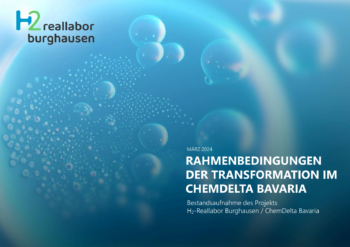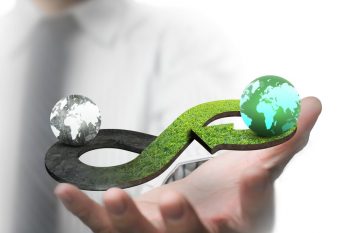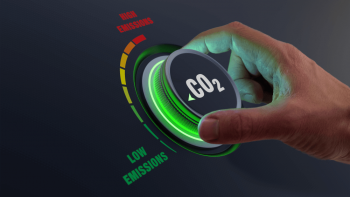Challenges for companies in 2023: Sustainability reporting in the light of life cycle assessment and the circular economy as part of the EU’s Sustainable Finance Strategy
The three most important new EU regulations, the Corporate Sustainability Reporting Directive (CSRD), the EU Taxonomy and the Sustainable Finance Disclosure Regulation (SFDR), are part of a broader EU “Sustainable Finance Framework”, which obliges companies to provide sustainability information and aims to create transparency for consumers. Its overarching goal is to drive the decarbonization of the economy with a stronger focus on corporate environmental and social responsibility. A year ago, FfE had already reported on the increasing requirements in sustainability reporting and the resulting new challenges for companies in the energy industry. These include both qualitative disclosures and quantitative indicators [1]. While the taxonomy is a classification system for economic activities, SFDR and CSRD include disclosure obligations. Among other things, these disclosure obligations also require companies to provide information on their taxonomy-compliant activities. The following article takes a closer look at which companies are affected by these regulations and the growing importance of the life cycle assessment and the circular economy in this context.
Who will be affected by the regulations and when?
As the successor to the Non-Financial Reporting Directive (NFRD), also known as the CSR Directive in Germany, the CSRD is aimed directly at companies and determines the disclosure of sustainability information. The CSRD is intended to make transparency in the areas of environment, social affairs and corporate governance the norm. In addition, the CSRD increases the number of companies subject to reporting requirements from 11,700 to almost 50,000 European companies [2]. This results from the expansion to all large companies and listed small and medium-sized enterprises (SMEs). From the 2024 financial year, companies will have to report in accordance with the CSRD guidelines (see Figure 1).
The SFDR, on the other hand, applies to financial market participants. They must disclose in periodic reports the extent to which their financial products take sustainability into account. This indirectly affects the companies in which investments are to be made, as the SFDR requires financial companies to provide the necessary sustainability information, which also requires taxonomy information. The SFDR has already been in force since 2021 and will be fully applied by the end of 2023.
The EU taxonomy is a classification system for sustainable economic activities. Based on various technical evaluation criteria, individual economic activities of a company can be classified as taxonomy-compliant or non-taxonomy-compliant for the six goals defined in the taxonomy. From this classification, the share of taxonomy-compliant (colloquially sustainable) activities in economic indicators (such as turnover, capital expenditure or operating costs) of a company can be determined. In order to make the technical assessment criteria for each individual economic activity easily accessible, the EU has used the taxonomy compass to prepare objectives 1 and 2 (climate change mitigation and climate change adaptation) of the delegated climate act. In the future, this will be expanded to include goals 3-6 (the sustainable use and protection of water and marine resources, the transition to a circular economy, pollution prevention and control and the protection and restoration of biodiversity and ecosystems). This allows companies to verify which economic activities are included in the taxonomy and which technical assessment criteria they need to fulfil in order to classify their corresponding activities as taxonomy-eligible. Targets 1 and 2 have already been in force since 1.1.2022, the remaining four targets are to come into force on 1.1.2023.

What is the role of life cycle methods (especially LCA and Scope 3)?
Life cycle assessment is also gaining importance for corporate sustainability reporting in EU regulations. Life cycle assessment (LCA) and the accounting of greenhouse gas (GHG) emissions according to the Greenhouse Gas Protocol (GHG Protocol), subdivided into Scopes 1, 2 and 3, play an important role. While LCA assesses various environmental impacts of products or services, GHG accounting according to the GHG Protocol refers to the organizational or company level. Despite the different objects of investigation (product vs. company), however, an LCA and also the Scope 3 emissions according to the GHG Protocol record such environmental or climate impacts that go far beyond the pure effects within the company. This is because both the LCA and the accounting of Scope 3 emissions take into account the entire life cycle of the product or the company (more information: Carbon Footprints of companies).
The proposal of the CSRD Directive of the 21st of April 2021, approved on the 28th of November 2022 by the Council of the European Union, includes an explicit consideration of life cycle assessment in the course of the expansion of sustainability reporting [3]. Thus, Article 19a, (2) e) ii) and Article 29a, (2) e) ii) require a description of the most important actual or potential sustainability risks and impacts across the entire value chain, including the supply chain [4]. The sustainability information provided should also be reported for short, medium and long-term periods. While the CSRD provides the requirements, the European Sustainability Reporting Standards (ESRS) of the European Financial Reporting Advisory Group (EFRAG) define the exact content to be reported. According to the current status, the ESRS working paper climate change [5] specifies that emissions at the corporate level, including Scope 3 emissions, must be reported in accordance with the GHG Protocol [6] or ISO 14064-1. Both the GHG Protocol and the ISO 14064-1 standard, which refers to the GHG Protocol, describe a standardized procedure for recording GHG emissions at the organization level in this context. Further key figures to be reported are the measurable targets for climate protection and adaptation to climate change. For this purpose, companies should report their reduction targets in the area of scope 1, 2 and 3 emissions.
Regarding the justified concern that the reporting obligations could become a “bureaucratic monster” for companies, the European Commission stated that although there may be an increased effort in the short term, in the medium to long term the reporting costs will even be reduced due to the interlocking of the reporting standards (SFDR, CSRD, taxonomy) [7]. The cooperation with the Global Reporting Initiative (GRI) should promote the international convergence of sustainability reports. Companies that already report according to such a reporting standard should thus have a good starting point [8]. In order to facilitate the adaptation, especially for SMEs to provide information on the value chain, a transition period of three years applies to them [4].
The EU Taxonomy Regulation also describes in Article 19, (1), g) that the technical assessment criteria must take into account the life cycle of an economic activity, including environmental impacts and effects [9]. While some activities, such as electricity generation from wind power or photovoltaics, automatically make a significant contribution to climate protection and thus meet the first objective, other activities, such as electricity generation from hydropower or gas-fired power plants, must meet further criteria. One of these criteria is life-cycle GHG emissions of less than 100 g CO2 eq. per kilowatt-hour [10]. The Commission Recommendation 2013/179/EU is to be used to calculate life-cycle GHG emissions. This is based on common methodology guidelines for life cycle and GHG accounting, such as life cycle accounting according to ISO 14040/44 . Alternatively, the standards ISO 14067 (carbon footprint of products) or ISO 14064-1 (quantitative determination of GHG emissions at the organization level) can be applied.
The SFDR requires disclosure of GHG emissions for scope 1 to 3 [11]. Products that advertise ESG characteristics (Article 8) or claim to be a sustainable investment (Article 9) must monitor the environmental or social characteristics promoted by the financial product and the indicators used to measure them throughout the life cycle of the financial product [12] (Articles 30 and 43).
What role does the circular economy play?
In March 2020, the European Commission adopted the action plan for the circular economy [13]. For a transformation of the economy, this also plays a major role in the EU’s Sustainable Finance Framework. The circular economy leads to a fundamental change in production methods, an adjustment of supply chains and a transformation of previous business models. To enable this, the CSRD Directive requires in article 19b, (2) a) that companies disclose resource use and circular economy factors in their sustainability reporting [3]. Furthermore, the working paper “E5 Circular Economy” of the European Sustainability Reporting Standards defines further disclosures on the circular economy [14]. For example, a description of the measures taken to transition from a linear business model to a circular economy is required. This includes an indication of the main risks of remaining in a linear economy and the main impacts, opportunities and risks of a transition to the circular economy. In this context, targets for circular material use or waste prevention have to be described as well as the resource inflow and outflow quantified according to “reused”, “recycled” and “renewable”. For example, for the key figure “resource inflow”, both the absolute quantity of recycled and reused materials and their percentage of the total quantity should be specified. This concerns services, manufacturing and packaging of the company’s primary products.
Since one of the six objectives of the taxonomy is “the transition to a circular economy”, an economic activity can be classified as taxonomy-compliant if it contributes to this objective [9] (Article 28). This can be done by, among other things, using resources and energy more efficiently, increasing the durability, repairability or recyclability of products, and replacing or reducing hazardous substances. Furthermore, improving waste management, including by improving waste management infrastructure, also contributes to a circular economy [9] (Article 13). Since the taxonomy requires that a taxonomy-compliant economic activity must not harm any of the five other objectives, this also means that an economic activity that works against the circular economy cannot be classified as taxonomy-compliant.
According to the SFDR, a sustainable investment corresponds to an economic activity if this investment contributes to the achievement of an environmental goal, for example the circular economy, or to the achievement of a social goal (Article 2). In addition, the circular economy also plays a central role through the interlinking of the SFDR with the fourth goal of the taxonomy “transition to a circular economy” [15]. This integration of the circular economy results from the mandatory pre-contractual and periodic reports in the SFDR (see Annex 2-5) regarding information on taxonomy-capable and taxonomy-compliant components of the financial product.
How can we support you?
FfE has already gained experience with the new regulations and their significance for companies in the real and financial economy. For example, FfE has supported EnBW Energie Baden-Württemberg in the evaluation of green investments with the help of LCA training and analyses, prepared a guideline for the quantification of sustainability indicators for alpitronic GmbH, and developed a suitable methodology and data basis for the evaluation of avoided emissions for Aquila Capital.
We would also be happy to support your company in preparing for the new requirements:
- Translating the regulations into concrete requirements for the collection and preparation of energy and emissions data for reporting
- Training and development of methodological expertise in the field of emissions accounting & “Life Cycle Assessment (LCA)” methodology in your company (Link)
- Carrying out life cycle assessments
- Preparation of guidelines for the quantification of sustainability indicators
- Identification and evaluation of circular economy measures
Contact us without obligation at: aisbert@ffe.de, aregett@ffe.de, +49 (0)89 158121-45 or info@ffe.de
This article and any information accessed via links in this article are provided for informational purposes only and do not constitute legal advice.
References
[1] Europäische Kommission. (2021). DELEGIERTE VERORDNUNG (EU) …/… DER KOMMISSION zur Ergänzung der Verordnung (EU) 2020/852 des Europäischen Parlaments und des Rates durch Festlegung des Inhalts und der Darstellung der Informationen, die von Unternehmen, die unter Artikel 19a oder Artikel 29a der Richtlinie 2013/34/EU fallen, in Bezug auf ökologisch nachhaltige Wirtschaftstätigkeiten offenzulegen sind, und durch Festlegung der Methode, anhand deren die Einhaltung dieser Offenlegungspflicht zu gewährleisten ist. Abgerufen am 30. November 2022, von https://eur-lex.europa.eu/legal-content/DE/TXT/?uri=PI_COM%3AC%282021%294987
[2] European Parliament. (2022). Sustainable economy: Parliament adopts new reporting rules for multinationals. Abgerufen am 30. November 2022, von https://www.europarl.europa.eu/news/en/press-room/20221107IPR49611/sustainable-economy-parliament-adopts-new-reporting-rules-for-multinationals
[3] Europäische Kommission. (2021). RICHTLINIE DES EUROPÄISCHEN PARLAMENTS UND DES RATES zur Änderung der Richtlinien 2013/34/EU, 2004/109/EG und 2006/43/EG und der Verordnung (EU) Nr.537/2014 hinsichtlich der Nachhaltigkeitsberichterstattung von Unternehmen. Abgerufen am 13. Dezember 2022, von https://eur-lex.europa.eu/legal-content/DE/TXT/PDF/?uri=CELEX:52021PC0189&from=EN
[4] Amtsblatt der Europäischen Union. (2022). Richtlinie (EU) 2022/2464 des Europäischen Parlaments und des Rates vom 14. Dezember 2022 zur Änderung der Verordnung (EU) Nr. 537/2014 und der Richtlinien 2004/109/EG, 2006/43/EG und 2013/34/EU hinsichtlich der Nachhaltigkeitsberichterstattung von Unternehmen (Text von Bedeutung für den EWR). Abgerufen am 12. Januar, von https://eur-lex.europa.eu/legal-content/DE/TXT/PDF/?uri=CELEX:32022L2464&from=EN
[5] European Financial Reporting Advisory Group. (2022). [Draft] European Sustainability Reporting Standard E1 Climate change. Abgerufen am 14. Dezember 2022, von https://www.efrag.org/Assets/Download?assetUrl=/sites/webpublishing/SiteAssets/Appendix%202.5%20-%20WP%20on%20draft%20ESRS%20E1.pdf
[6] World Resources Institute & wbcsd. (2013). Technical Guidance for Calculating Scope 3 Emissions. Abgerufen am 8. Dezember 2022, von https://ghgprotocol.org/sites/default/files/standards/Scope3_Calculation_Guidance_0.pdf
[7] European Commission. (2021). Questions and Answers: Corporate Sustainability Reporting Directive proposal. European Commission. Abgerufen am 14. Dezember 2022, von https://ec.europa.eu/commission/presscorner/detail/en/qanda_21_1806
[8] EFRAG. (2021). EFRAG invited to contribute immediately to the elaboration ofdraft EU sustainability reporting standards (ESRS). Abgerufen am 16. Januar 2023, von https://www.efrag.org/Assets/Download?assetUrl=%2Fsites%2Fwebpublishing%2FSiteAssets%2FEFRAG%2520%2520PTF%2520ESRS%2520composition%2520and%2520kick%2520off%2520FINAL.pdf
[9] Europäische Union. (2020). Verordnung (EU) 2020/852 des Europäischen Parlaments und des Rates vom 18. Juni 2020 über die Einrichtung eines Rahmens zur Erleichterung nachhaltiger Investitionen und zur Änderung der Verordnung (EU) 2019/2088 (Text von Bedeutung für den EWR). In Amtsblatt der Europäischen Union. Abgerufen am 14. Dezember 2022, von https://eur-lex.europa.eu/legal-content/DE/TXT/PDF/?uri=CELEX:32020R0852&from=de
[10] Europäische Union. (2021). Delegierte Verordnung (EU) 2021/2139 der Kommission vom 4. Juni 2021 zur Ergänzung der Verordnung (EU) 2020/852 des Europäischen Parlaments und des Rates durch Festlegung der technischen Bewertungskriterien, anhand deren bestimmt wird, unter welchen Bedingungen davon auszugehen ist, dass eine Wirtschaftstätigkeit einen wesentlichen Beitrag zum Klimaschutz oder zur Anpassung an den Klimawandel leistet und anhand deren bestimmt wird, ob diese Wirtschaftstätigkeit erhebliche Beeinträchtigungen eines der übrigen Umweltziele vermeidet (Text von Bedeutung für den EWR). In Amtsblatt der Europäischen Union. Abgerufen am 14. Dezember 2022, von https://eur-lex.europa.eu/legal-content/DE/TXT/PDF/?uri=CELEX:32021R2139&from=EN
[11] European Commission. (2022). ANNEX 1. Abgerufen am 14. Dezember 2022, von https://ec.europa.eu/finance/docs/level-2-measures/C_2022_1931_1_EN_annexe_acte_autonome_part1_v6.pdf
[12] European Commission. (2022). COMMISSION DELEGATED REGULATION (EU) . . ./. . .of 6.4.2022 supplementing Regulation (EU) 2019/2088 of the European Parliament and of the Council with regard to regulatory technical standards specifying the details of the content and presentation of the information in relation to the principle of ‘do no significantharm’, specifying the content, methodologies and presentation of information in relation to sustainability indicators and adverse sustainability impacts,and the content and presentation of the information in relation to the promotion of environmental orsocial characteristics and sustainable investment objectives in pre-contractual documents, on websites and in periodic reports(Text with EEA relevance). Abgerufen am 14. Dezember 2022, von https://ec.europa.eu/finance/docs/level-2-measures/C_2022_1931_1_EN_ACT_part1_v6%20(1).pdf
[13] Europäische Kommission. (o. D.). Circular economy action plan. Environment. Abgerufen am 14. Dezember 2022, von https://environment.ec.europa.eu/strategy/circular-economy-action-plan_de
[14] European Financial Reporting Advisory Group. (2022). [Draft] European Sustainability Reporting Standard E5 Resource Use and Circular Economy. Abgerufen am 14. Dezember 2022, von https://efrag.org/Assets/Download?assetUrl=%2Fsites%2Fwebpublishing%2FSiteAssets%2FWorking%2520paper%2520on%2520draft%2520ESRS%2520E5%2520Resource%2520use%2520and%2520Circular%2520Economy%2520vf.pdf
[15] Europäische Union. (2019). VERORDNUNG (EU) 2019/2088 DES EUROPÄISCHEN PARLAMENTS UND DES RATES vom 27. November 2019 über nachhaltigkeitsbezogene Offenlegungspflichten im Finanzdienstleistungssektor (Text von Bedeutung für den EWR). Amtsblatt der Europäischen Union. Abgerufen am 14. Dezember 2022, von https://eur-lex.europa.eu/legal-content/DE/TXT/PDF/?uri=uriserv:OJ.L_.2019.317.01.0001.01.DEU


